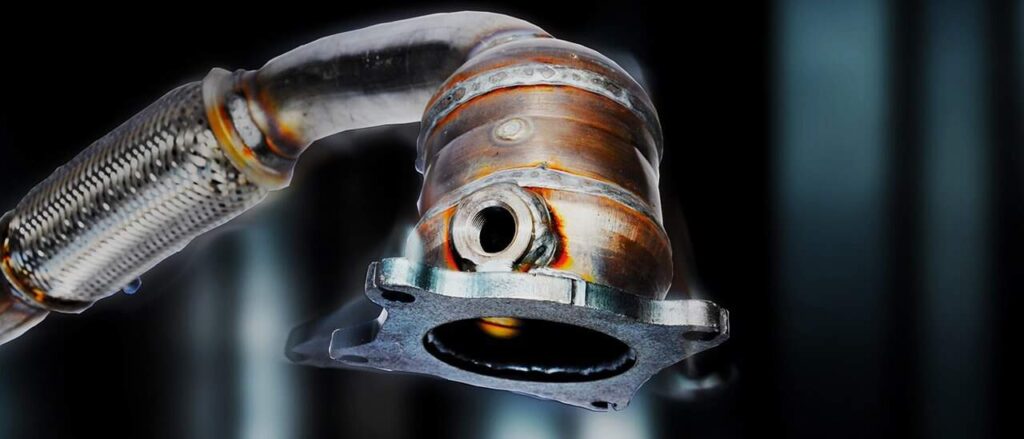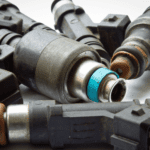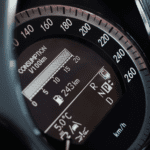A catalytic converter takes harmful pollutants and converts them through a chemical reaction into less harmful water vapor and carbon dioxide. Once a catalytic converter has been replaced, you wouldn’t expect unusual smells to come from it, so what do new catalytic converters smell like, and when is it not normal?
Normal New Catalytic Converter Smells
Catalytic converters usually have a couple of expected smells for the first day or so. All unusual smells should disappear after an hour or so of driving, but some can stick around for a few days; these include:
- Label burning—Catalytic converters have labels applied with supplier part numbers attached; mechanics usually do not remove them before installation, even though they should. The labels burn away as the catalytic converter heats for the first time. In addition to a burning smell, you may notice a small amount of smoke, which will only last a few days.
- Exhaust putty – When a new section of the exhaust is replaced, the catalytic converter included. A sealing putty is applied around the exhaust gaskets to seal two components. Depending on the sealant used, some can take up to 24 hours to cure and smell funny for a little while afterward.
- Oil coating – Catalytic converters and all new exhaust components have an oil coating to protect them from rusting when stored on the shelves as new. The exhaust coating usually burns off within a few hours but you can smell it while it does.
Bad New Catalytic Converter Smells
There are certain smells you should be wary of that indicate an issue, most likely a faulty catalytic converter; they include:
- A Strong exhaust fumes smell – Pinhole leaks between the welds or joins that haven’t been sealed correctly will allow a small amount of exhaust gasses to escape. You would expect a louder noise from the exhaust, but with minor leaks, this isn’t always the case. You may also sense a stronger smell of exhaust gasses in the cabin because the exhaust fumes are not pushed out of the back of the car like normal.
- Sulphuric smells – Catalytic converters convert the small amount of sulfur found in fuel into odorless sulfur dioxide. When the catalytic converter fails, you get a strong eggy smell, this is the scent of sulfur no longer being converted. It is undoubtedly bad when a new catalytic converter smells like rotten eggs. If this smell is present with a new catalytic converter, it suggests it is faulty.
What to Do if You Find the New Catalytic Converter Smells?
If you notice unpleasant smells from your car’s new catalytic converter that persist for more than 24 hours, it’s best to return your car to the mechanic who fitted it for inspection. Although there may be no problem, the catalytic converter may still be “bedding” in. The mechanic will examine the smells and may use an OBD code reader to check the operation of the catalytic converter and O2 sensors. If an OBD reader is unavailable, the mechanic can use an exhaust gas emissions tester to determine if the catalytic converter is functioning correctly.
While most vehicle components come with a standard 12-month warranty, some garages offer an extended warranty on catalytic converters. If the catalytic converter is faulty, it would typically be replaced under warranty, provided no further issues are causing it to fail.

Other Signs a New Catalytic Converter Has Failed
Unusual smells are not the only thing to look out for to determine if the catalytic converter, either new or old, is faulty; the most common are:
- Change in color – If your vehicle’s catalytic converter glows red and turns blue when cooled, it means the temperature inside has exceeded normal levels due to a lean or rich engine. Usually, this is caused by an oxygen sensor not operating correctly. A color change in the catalytic converter means irreversible damage has been done.
- Loud noises – The catalytic converter is no different from any other exhaust section; if it fails, the internals will rattle, and you may hear an unusual raspy tone when revving the engine.
- Failed emissions test – The catalytic converter removes harmful pollutants from exhaust gasses through a redox reaction. When a catalytic converter is faulty, it will often fail an emissions test.
- Misfires – Engine misfires can occur when the catalytic converter becomes blocked. This can happen due to the fuel mixture in the engine being either too rich or too lean. This results in an incomplete combustion, and unburned fuel gets sent to the catalytic converter, causing it to become blocked. This will often trigger the check engine light to come on at the same time.
What Would Cause a New Catalytic Converter to Fail?
Catalytic converters usually fail because of an imbalance in the air-fuel mixture combusting in the engine. If this happens when you have a new catalytic converter, it could indicate a problem with one of the O2 sensors.
A catalytic converter can also be supplied faulty; as you can imagine, aftermarket exhaust components are made in huge batches, so you can expect one or two to be faulty. It will just be bad luck, as unless the catalyst inside is rattling, a mechanic can’t tell that it is defective before installing it. Faulty catalytic converters don’t typically manifest until you’ve driven for a day.
Do You Have to Break in a New Catalytic Converter?
New catalytic converters have a bedding in the process when new; they need to get up to temperature to burn away any contaminants without getting too hot, so keep the revs down for the first 15 minutes. After they’ve worked up to operating temperature, they require cooling down naturally, so leave the car idling for a few minutes before switching off.
Suppose you immediately start the car after replacing the catalytic converter and thrash it down the road. In that case, you risk causing a blockage inside or causing the internals to break down.
Most mechanics usually carry the bedding in process for you after replacing the catalytic converter. When installed, they will start it and leave the idling while doing their final checks, ensuring no exhaust leaks. The 10-15 minutes they have the car idling on a ramp is enough to break in the new catalytic converter.
Last Points
New catalytic converter smells are usual and should disappear after a day or two. If you sense an unusual eggy or gas fumes smell, you should take the car back to the mechanic to inspect. Occasionally, aftermarket catalytic converters are installed faulty, but not at the mechanic’s fault because it is impossible to tell beforehand. A newly replaced catalytic converter should have some form of warranty if the part is faulty. However, it would be best if you were sure there were no further problems with any other factors of your car that could affect the catalytic converter, as you will need to put them right to stop another catalytic converter from going faulty.









